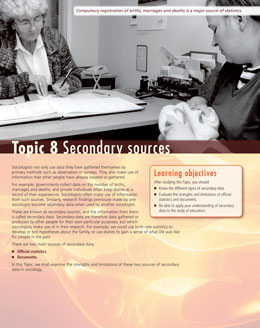 Read the section on Official Statistics, pages 219 to 222, then use the example of crime statistics to analyse another area of research – homelessness. Study the extract below and then answer the questions that follow:
Read the section on Official Statistics, pages 219 to 222, then use the example of crime statistics to analyse another area of research – homelessness. Study the extract below and then answer the questions that follow:
To most people the word ‘homeless’ would suggest those who are living on the street with no roof over their heads. However, the official definition of homelessness is wider than this and includes all those in accommodation that is temporarily provided by local authorities. This official definition only includes those classified by local authorities as having a ‘priority need’; the local authority is bound by statute to find accommodation for them. Included here are people with dependent children and those who are vulnerable with some physical or mental health problem – mostly the elderly, mentally ill or handicapped. These are the people who are included in the official statistics. This means that single people who are sleeping rough are not included.
However, in 2004 the government announced that a much higher proportion of the homeless were in good quality accommodation (80%, compared to 65% in 1997).
The charity ‘Crisis’ also refers to the ‘hidden homeless’ – who may not be sleeping rough or applying to the local authority for help. The ‘hidden homeless’ are often single people with no dependents. This category may include squatters, those in hostels and those sleeping on other people’s floors – even young people who are still sharing overcrowded accommodation with their parents.
(a) Why does the information above suggest that official statistics may be invalid?
(b) In what way could these statistics be said to be ‘socially constructed’?
(c) Why might a government want to ‘control’ the statistics of homelessness?
(d) How would you attempt to provide a more valid definition of homelessness?
(e) What research method would you use to try to uncover the true level of people sleeping rough in a British city?

